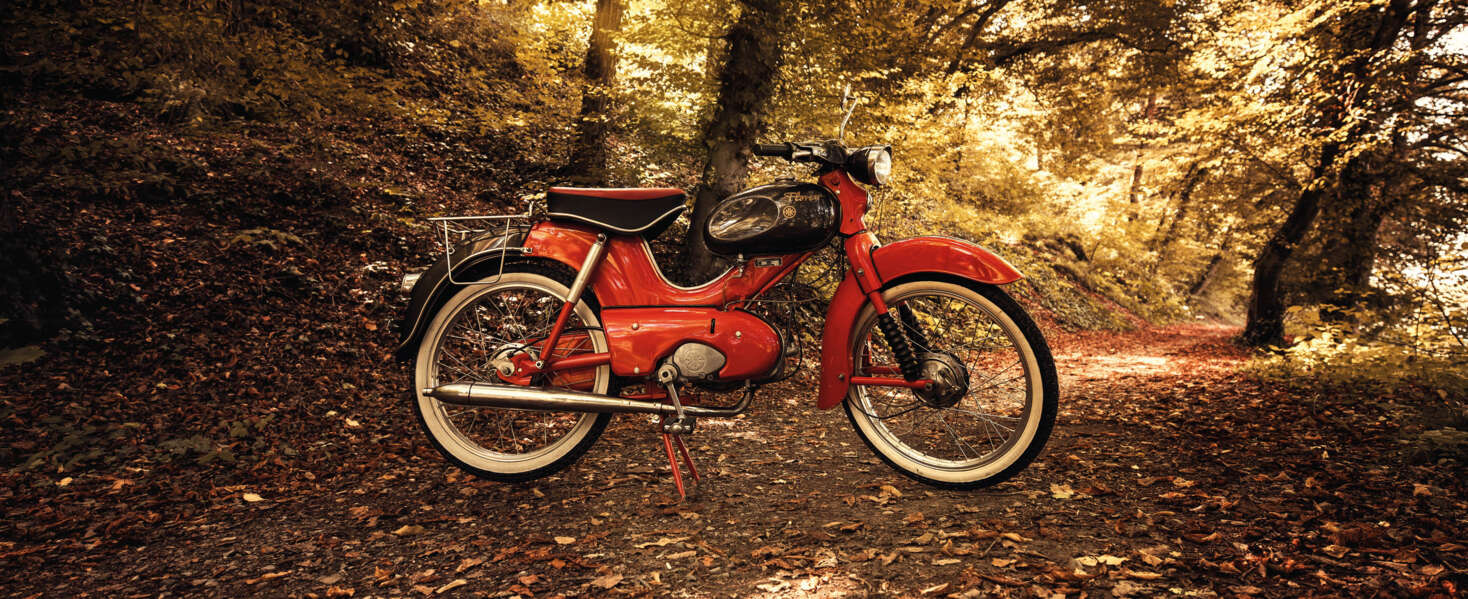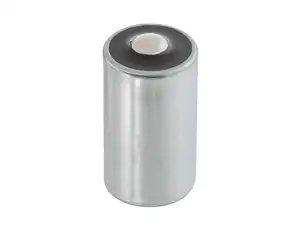
KREIDLER
Kreidler - more than the world record moped

The Flory moped, the Florett-RS motorbike and the K50 motorbike are still unforgotten today and were the flagships of the moped manufacturer from Kornwestheim. To this day, these and other moped models from the brand are among the favourite classics and enjoy great popularity. Unfortunately, like so many moped manufacturers, the company, which was founded in 1903, finally ceased operations and production in 1982 after several bankruptcies. We introduce you to the manufacturer and its best-known models in a little more detail.
| Seat |  |
| Status | |
| Foundation | 1903 |

From metal workshop to two-wheeler forge
Slow riding culture was never the predominant company philosophy at Kreidler, quite the opposite. Mopeds and two-wheelers from the manufacturer from the small Swabian town of Kornwestheim were always intended to be fast - and they were. Every moped enthusiast will certainly be familiar with the record-breaking ride of the Kreidler Cigar on the Great Salt Lake in Utah in 1965, which we will come to later. But the manufacturer started out as a fairly ordinary metalworking company. The origins of the company are therefore comparatively staid and tranquil: the company was founded in 1903 in Stuttgart, Swabia, as a specialist in copper cables and brass rods for overland electric cables. The Swabian manufacturer was also already experimenting with aluminium, a relatively new material at the time. However, it was only when the racing-enthusiastic son of company founder Anton Kreidler joined the company in 1924 that the business with fast racing motorbikes was also discovered in Kornwestheim. However, the first 350 cc machines built in Kornwestheim at that time were only a small sideline or a technical gimmick for the son Alfred Kreidler. This only changed when he took over the management of the company after the death of his father in 1942.
66HEROES license plate holder set side & frame incl. mounting pin (DE version)
Manufacturer: 66HEROES · Material: Aluminum · Material: Chrome steel (colloquially known as stainless steel) · Surface: anodized · Mounting type: Nuts & bolts · Number of fixing points: 3 pcs · Color: Chrome · Color: black
92,70 EUR
73,90 EUR

Breaker with cable (Budget) | Bosch / Ducati
Number of fixing points: 1 pcs · Ø mounting hole: 4.5 mm · Manufacturer: Quenching · Material: Steel · Ø Internal flywheel: 90 mm · Area of application: Original · Area of application: Standard · Cable length: 100 mm · Cable available: Yes · Ø axle: 4 mm · BOSCH OEM number: 1 217 013 025 · BERU OEM number: 0 340 100 710
8,10 EUR

HPI racing ignition 12V with light 60W
Number of fixing points: 6 pcs · Manufacturer: HPI · Material: Aluminum · Material: Steel · Ø Internal flywheel: 61.5 mm · Area of application: Tuning · Tension: 12 V · Light coil voltage: 12 V · Performance: 60 W · Direction of rotation: left · Direction of rotation: right · Weight: 340 g · Ø mounting plate: 90 mm · Mounting type: Screws · Ø Flywheel outside: 71.5 mm · Ø cable: 7 mm
352,30 EUR

EFFE breaker with cable | Bosch / Ducati
Number of fixing points: 1 pcs · Ø mounting hole: 4.5 mm · Manufacturer: EFFE · Material: Steel · Ø Internal flywheel: 90 mm · Area of application: Original · Area of application: Standard · Cable length: 100 mm · Cable available: Yes · Ø axle: 4 mm · BOSCH OEM number: 1 217 013 025 · BERU OEM number: 0 340 100 710
16,30 EUR

BOSCH capacitor for soldering (high) | Bosch / Ducati
Height: 32 mm · Manufacturer: BOSCH · Ø outside: 18 mm · Area of application: Original · Area of application: Standard · Mounting type: Plug connection clamped · Connection type: Soldering · Total height: 34 mm · Kreidler OEM number: 08 16 33 · Zündapp OEM number: 277 07 909 · Puch OEM number: 500 2 50 013 2 · Sachs OEM no.: 0 965 091 000 · BOSCH OEM number: 1 237 330 037
26,90 EUR

BERU breaker without axle | Bosch ignition
Number of fixing points: 1 pcs · Ø mounting hole: 4.5 mm · Manufacturer: BERU · Material: Steel · Area of application: Original · Area of application: Standard · Cable available: No · Ø axle: 4 mm · Pony OEM number: A4606 · Sachs OEM no.: 0983 106 000 · BOSCH OEM number: 1 217 013 015 · BERU OEM number: 0 340 100 436
23,40 EUR

BOSCH Breaker without cable | Bosch / Ducati
Number of fixing points: 1 pcs · Ø mounting hole: 4.5 mm · Manufacturer: BOSCH · Material: Steel · Area of application: Original · Area of application: Standard · Cable available: No · Ø axle: 4 mm · BOSCH OEM number: 1 217 013 021 · BERU OEM number: 0 340 100 465
26,90 EUR

BOSCH capacitor for soldering (low) | Bosch / Ducati
Height: 25.5 mm · Manufacturer: BOSCH · Area of application: Original · Area of application: Standard · Ø outside: 18 mm · Mounting type: Plug connection clamped · Connection type: Soldering · Total height: 28 mm · Pony OEM number: A2090 · Zündapp OEM number: 266 07 903 · Puch OEM number: 302 1 50 013 2 · Puch OEM number: 364 4 50 513 2 · Sachs OEM no.: 0265 052 033 · Sachs OEM no.: 0265 052 003 · BOSCH OEM number: 1 237 330 035
23,40 EUR
Page 1 of 27
The first mopeds and motorbikes
After the end of the war and the reconstruction of the company, the manufacturer went all-in on the development of motorbikes with 50 cc engines. The K50 motorbike or, as it is known in German, Motorfahrrad, was the first mass-produced two-wheeler to leave the factory halls. The single-cylinder engine had a displacement of 50 cm³ and produced around 2 hp at 5000 rpm. With a top speed of 50 to 55 km/h, the K50 moped was quite nippy. The K50 models therefore delivered a performance that could easily compete with the 98 cc motorised bikes that were common at the time. Even if real moped lovers will only be marginally interested, the vehicle manufacturer launched a scooter on the market at almost the same time, the Amazone, which was also powered by the K50 engine. The K50 mopeds and the successor model K51, which was already equipped with footrests and a kick-start mechanism as standard at the time, enjoyed great popularity. These first Kreidler mopeds had a reputation for being very robust, powerful and comparatively inexpensive.

The legendary Kreidler Flory moped
Every moped enthusiast knows that Kreidler did not only build particularly fast two-wheelers, even though, as we will tell you later, the manufacturer became famous for precisely that. The first official moped, as this vehicle class did not yet officially exist when the K50 velomotorcycles described above were launched, was the MF 4 model, which was built from 1969 to 1975. As is typical for all of the manufacturer's models, the D 15.02 2-stroke engine with one cylinder was fitted horizontally. A particularly innovative feature of this Hödi was the new type of light alloy cylinder, with which the moped delivered a solid 1.5 hp. Kreidler sold a total of over 55,000 units of the MF4. The successor models from 1975 went under the name Kreidler Flory MF 12 or MF13 and from 1977 Flory MF23. The various versions differed only marginally in terms of power output, which was 1.5 hp. All versions reached a top speed of 25 km/h. Following the subsequent bankruptcy of the Swabian moped manufacturer in 1982, the mopeds were marketed by the Italian two-wheeler manufacturer Garelli for a further three years. However, only the side panelling and the tank of these late Flory mopeds were true to the model; the rest of the moped was a series-produced Garelli model.

Need for Speed - the Florett series
One of the Kornwestheim two-wheeler manufacturer's most legendary models is certainly the Florett series of two-wheelers. The first two-wheelers in this family motorised with the K54 engine were launched in 1957. Strictly speaking, most of the models were not genuine motorbikes, but mopeds. However, there was also a moped version of the Florett with a K54 engine, although production of this was discontinued in 1962. With the Florett series, Kreidler focussed fully on increasing performance and speed. As early as 1960, the two-wheelers were properly upgraded so that the horizontally mounted, fan-cooled single-cylinder 2-stroke engine now produced 3.6 hp, and two years later the power was increased to 4.2 hp. The Florett Super TS variant further increased the engine output in 1966 to 5.2 hp and the GT and RS models even went one better the following year with 5.3 hp. This development culminated in the launch of the Kreidler Florett RS moped, which was built from 1967 to 1981 and of which over 125,000 units were sold. This fastest two-wheeler ever built by Kreidler ran at an incredible 85 km/h in the versions built after 1970.

A piece of racing history - the Utah world record
The background to this almost uninhibited increase in performance was a legal regulation in Germany, colloquially known as the "Lex Kreidler". According to this regulation, there were no limits on the speed and power of the engine for mopeds from 1954 onwards. The only restriction for the open mopeds, as these two-wheelers were also called, was the limitation of the engine to 50 cm³. Higher, faster and further, that was the objective in those years, which also led to the legendary record ride in 1965, in which a two-stroke engine tuned up to 12.5 hp catapulted a converted and streamlined Florett two-wheeler to the incredible speed of 225.3 km/h - a world record for 50 cc engines to this day. The Kreidler cigar thus broke the previous record of 196 km/h set by NSU while travelling on Lake Bonneville in Utah.
Mofas of desire from Kornwestheim
From today's perspective, this hunt for records and faster two-wheelers may seem a little antiquated for all fans of the slow riding culture. But Kreidler two-wheelers were an expression of a special yearning during the moped boom. Like Puch, Piaggio or Pony mopeds, the mopeds from Kornwestheim were also associated with the desire for freedom, individual mobility and the will to escape the sometimes somewhat too narrow world. This was particularly possible on the manufacturer's light motorbikes for the young moped enthusiasts of the time, just a little faster than on competing models from Switzerland, Austria or Italy.

Our favorite manufacturers

















